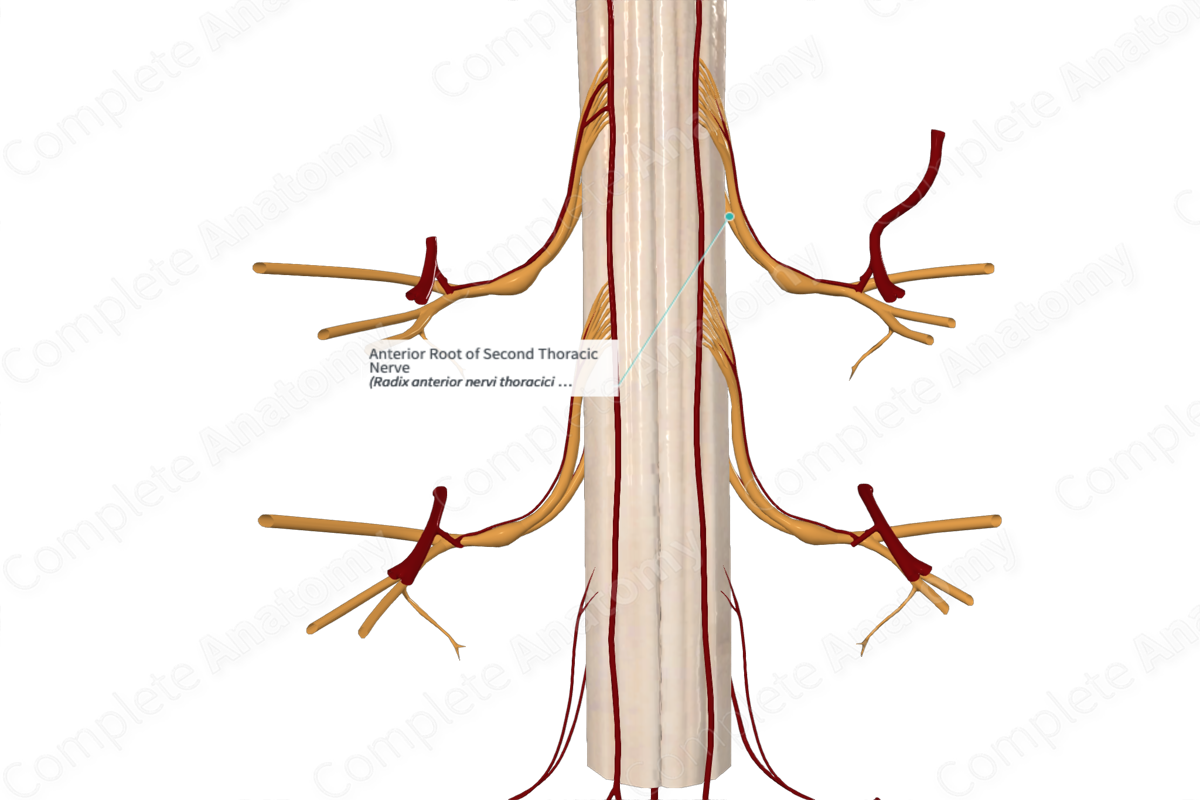
Anterior Root of Second Thoracic Nerve
Radix anterior nervi thoracici secundi
Read moreQuick Facts
Origin: Anterolateral sulcus of spinal cord.
Course: Laterally towards intervertebral foramen.
Branches: None.
Supply: Motor innervation to epaxial muscles of upper trunk, intercostal muscles of second intercostal space. Sympathetic targets in the thorax and territories of second thoracic nerve.
Related parts of the anatomy
Origin
The anterior root of the second thoracic nerve forms from a series of rootlets that emerge from the anterolateral sulcus of the second thoracic spinal segment.
Course
The anterior root of the second thoracic nerve runs laterally and inferiorly away from the second thoracic spinal segment towards the intervertebral foramen located between the second and third thoracic vertebrae. Roughly within this intervertebral foramen, the anterior root merges with the posterior root to form the second thoracic nerve.
Branches
The anterior root of the second thoracic nerve merges with the posterior root to form the second thoracic nerve and does so without branching.
Supplied Structures & Function
The anterior root of the second thoracic nerve supplies all efferents for the second thoracic nerve, both somatic and sympathetic.
The somatic efferents pass through the spinal nerve itself and into either the posterior ramus or the anterior ramus of the second thoracic nerve.
—Those fibers that enter the posterior ramus convey motor innervation to the epaxial muscles, including the erector spinae (iliocostalis, longissimus, spinalis), transversospinal (rotatores, multifidus, semispinalis), and deep segmental back muscles (interspinales, levatores costarum).
—Those fibers that enter the anterior ramus of the second thoracic nerve (or second intercostal nerve) receives efferents from the anterior root. It remains in the intercostal space to innervate the muscles of the second intercostal space (external intercostal, internal intercostal, innermost intercostal) and transversus thoracis muscle. A lateral branch of the intercostal nerve will innervate the serratus posterior superior muscle.
Preganglionic sympathetic efferents travel from the lateral horn of the second thoracic spinal cord segment, through the anterior root and into the second thoracic nerve. Just past the intervertebral foramen, sympathetic efferents leave the thoracic nerve via the white rami communicans to enter the sympathetic chain. The preganglionic sympathetic efferents of the anterior root of second thoracic nerve primarily affect sympathetic innervation of thoracic organs, such as the lungs and heart. Additionally, they control the sympathetic response in the glands and vessels of the upper thoracic dermatomes.
Learn more about this topic from other Elsevier products


